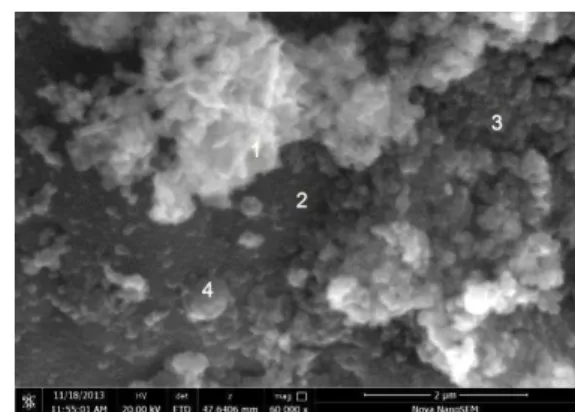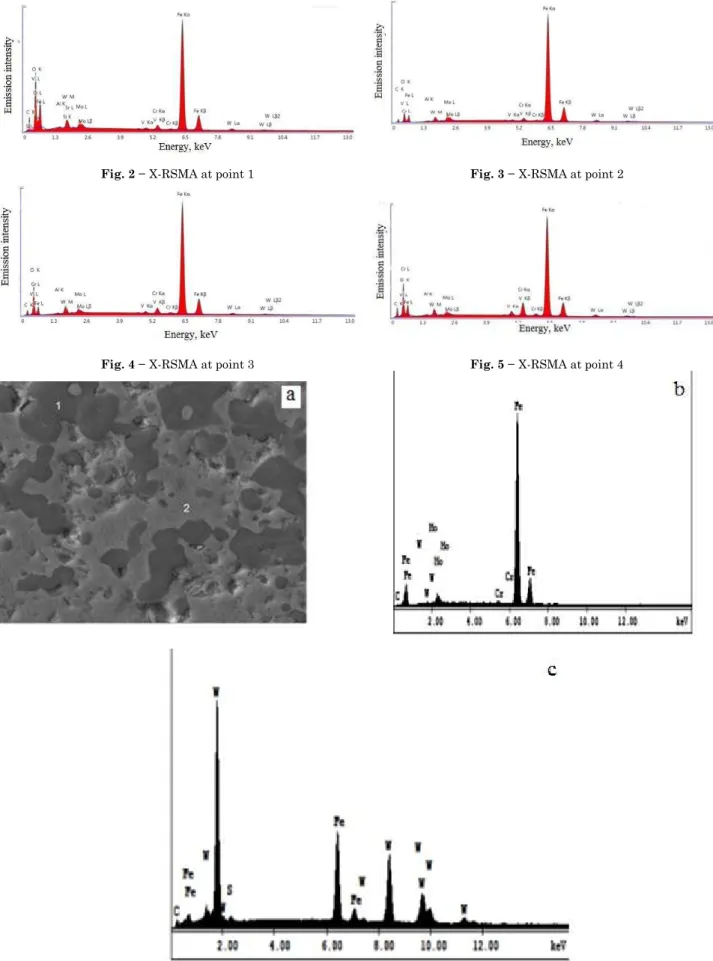JOURNAL OF NANO- AND ELECTRONIC PHYSICS Р А А - А Р
Vol. 6 No 3, 03049(3pp) (2014) Том6№ 3, 03049(3cc) (2014)
The article was reported at the International Conference «The Advanced Technology, Equipment and Analytical Systems for Materials», Kursk, 13-14 May, 2014
2077-6772/2014/6(3)03049(3) 03049-1 2014 Sumy State University
Studing Tungsten-containing Electroerosion Powders and Alloys Synthesized from Them
E.V. Ageev, E.V. Ageeva, V.Yu. Karpenko, A.S. Osminina
South-West State University, 94, 50 Let Oktyabrya Str., 305040 Kursk, Russia
(Received 19 May 2014; published online 15 July 2014)
The results of the X-ray spectral microanalysis of the powder obtained using electroerosion dispersion of tungsten-containing wastes in distilled water, and the alloy powder synthesized from this powder are presented in the article. It is shown that the basic elements both in the powder obtained using electroero-sion disperelectroero-sion of tungsten-containing wastes in distilled water and in the synthesized alloy are tungsten, molybdenum, iron, oxygen and carbon.
Keywords: Tungsten-containing wastes, Electroerosion dispersion, Distilled water, Tungsten-containing
powder, X-ray spectral microanalysis.
PACS numbers: 42.65.Dr, 75.60.Ch
1. INTRODUCTION
The analysis of the researches in the field of tung-sten-containing tooling materials shows that the majori-ty of them are related to the issue of tungsten saving. This issue is of great importance due to the shortage, high cost and the continuous widening of tungsten appli-cation areas. Activities aimed at wastes collection and processing are closely related with tungsten saving. Sev-eral methods of wastes processing are currently used in domestic and foreign industries. The characteristic fea-tures of these methods are large tonnage, energy intensi-ty, large industrial areas, low efficiency and also envi-ronmental problems [1, 2]. Method of electroerosion dis-persion (EED) is one of the most promising methods for producing powder from almost any current-conducting metal. This method has relatively low energy costs and is environmentally friendly [3-9].
The widespread use of EED method for processing tungsten-containing wastes (in particular high-speed steel) into powder with the purpose of their recycling is slowed down by the absence of comprehensive infor-mation on the influence of initial composition, conditions and environment on the properties of the powders in scientific and technical literature and by the absence of practical application technology. Therefore, it is neces-sary to conduct integrated theoretical and experimental studies to develop recycling technologies for powders produced from high-speed steel wastes, and to evaluate the efficiency of their use.
The objective of this work is to carry out X-ray spec-tral microanalysis (X-RSMA) of the powder produced using electroerosion dispersion of tungsten-containing wastes in distilled water and of the alloy synthesized from this powder.
2. MATERIALS AND METHOD OF EXPERIMENTAL PROCEDURE
A special unit for EED of current-conducting materi-als developed by the authors was used to produce powder from tungsten-containing wastes using electroerosion dispersion method [10, 11]. The wastes were put into the reactor filled with distilled water as working fluid. The process was carried out at the following electrical pa-rameters: the capacitance of the discharge capacitors
was 35 F, the voltage was 200 ... 220 V, time between pulses was 30 Hz. The destruction of waste material to form powder dispersion particles occurred as a result of the local impact of short-duration electrical discharges between the electrodes.
To carry out X-RSMA of the powder produced using electroerosion dispersion of tungsten-containing wastes in distilled water micrographs were made using scan-ning electron microscope “QUANTA 600 FEG”.
From the obtained powder produced using electroero-sion disperelectroero-sion of T15K6 hard alloy wastes the hard al-loy was synthesized using hot-pressing technique with the 3 minute high current passage in vacuum. The modi-fied hot-pressing technique, in which an electric current passes directly through the mold and the stock material, rather than through an external heater, is used as the basis of the process. A very fast heating and extremely short work-cycle time are achieved using pulsed electric current and the so-called „spark plasma effect‟.
The study of the microstructure and the composition of the elements of the synthesized alloys was carried on the basis of scanning electron microscope (SEM) investi-gation methods using a scanning electron microscope 200 Quanta 3D.
3. EXPERIMENTAL RESULTS AND
DISCATIONS
The micrographs of tungsten-containing powders are shown in Fig. 1.
Fig. 1− SEM- micrograph of the powder particles with the
E.V. AGEEV,E.V. AGEEVA, ET AL. J.NANO-ELECTRON.PHYS. 6, 03049 (2014)
03049-2
Fig. 2− X-RSMA at point 1 Fig. 3 − X-RSMA at point 2
Fig. 4− X-RSMA at point 3 Fig. 5− X-RSMA at point 4
Fig. 6− Microstructure a) and composition of the elements of the alloy, synthesized from the powder produced using
STUDING TUNGSTEN-CONTAINING ELECTROEROSION POWDERS… J.NANO-ELECTRON.PHYS.6, 03049 (2014)
03049-3 Then, at points 1-4 indicated on the resulted micro-graph, spectra of characteristic xeroradiography at dif-ferent points on the surface of the powder sample were obtained using EDAX energy dispersive X-ray analyz-er, built in the scanning electron microscope “QUANTA 600 FEG” (Fig. 2-5).
Spectra of characteristic xeroradiography corre-spond to the points in the figures. On the spectrum the peak of a certain height corresponds to each chemical element.
Then, at points 1 and 2 indicated on the resulting micrograph, spectra of characteristic xeroradiography on the surface of the sample were obtained (Fig. 6).
Spectra of characteristic xeroradiography corre-spond to the points in the figures. On the spectrum the peak of a certain height corresponds to each chemical element.
4. CONCLUSION
Thus, X-ray spectral microanalysis allowed deter-mining the composition of the elements of microobjects of powder particles produced using electroerosion dis-persion of tungsten-containing wastes on the basis of excited in them characteristic xeroradiography.
According to the results of the generalized present-ed data it was revealpresent-ed that tungsten, molybdenum, iron, oxygen and carbon are the main elements both in the powder produced using the method of electroero-sion disperelectroero-sion of tungsten-containing wastes in dis-tilled water, and in the synthesized alloy.
The work is carried out according to the topic of the Russian Ministry of Education and Science state task (Project № 2104).
REFERENCES
1. S.B. Maslenkov, Vse materialy. Entsiklopedicheskiy
spravochnik, No 1, 18 (2007) [in Russian].
2. T.B. Yershova, M.I. Dvornik, A.V. Zaytsev, Kompozity i
nanostruktury No 2, 40 (2011) [in Russian].
3. M.I. Dvornik, Razrabotka fiziko-khimicheskikh i tekhnolog-icheskikh osnov pererabotki vol'framokobal'tovogo tverdogo splava elektroerozionnym dispergirovaniyem: diss. … kand.
tekhn. nauk (Khabarovsk: 2006) [in Russian].
4. Ye.F. Nemilov, Elektroerozionnaya obrabotka materialov (Mashinostroyeniye, Leningr. otd-niye: L.: 1983) [in Rus-sian].
5. Ye.V. Ageyev, Uprochnyayushchiye tekhnologii i pokrytiya No 6, 8 (2011) [in Russian].
6. R.A. Latypov, G.R. Latypova, Ye.V. Ageyev, P.I. Burak,
Mezhdunarodnyy nauchnyy zhurnal No 5, 80 (2013) [in
Russian].
7. Ye.V. Ageyev, Tekhnologiya metallov No 9, 36 (2012) [in Russian].
8. Ye.V. Ageyev, Elektrometallurgiya No 10, 24 (2011) [in Russian].
9. E.V. Ageeva, E.V. Ageev, A.S. Osminina, J. Nano- and Elec-tron. Phys.5 No 4, 04038 (2013).
10. Ye.V. Ageyev, Patent 2449859, Rossiyskaya Federatsiya, C2, B22F9/14, № 2010104316/02; zayav. 08.02.2010; opubl. 10.05.2012. – 4 s [in Russian].

